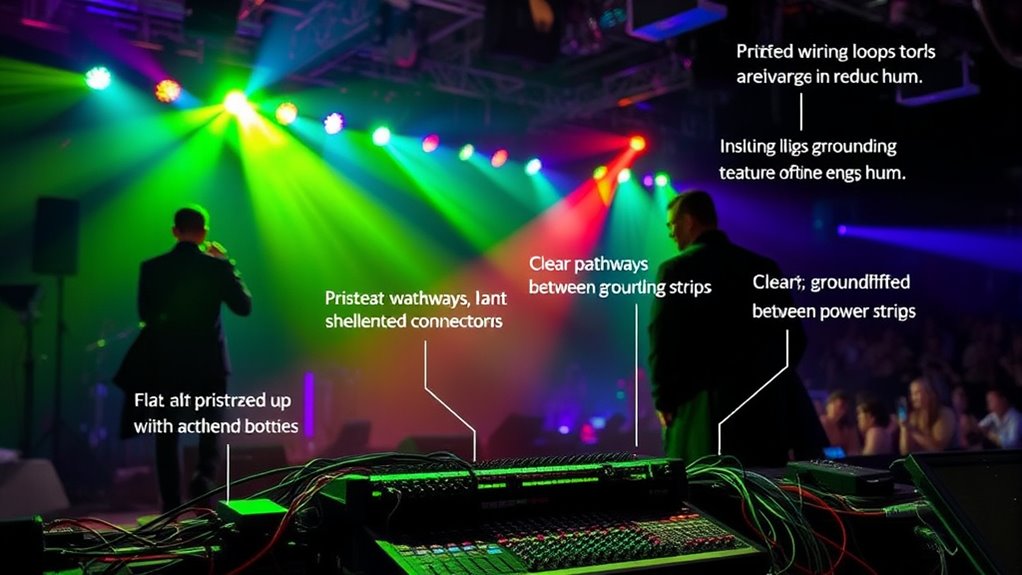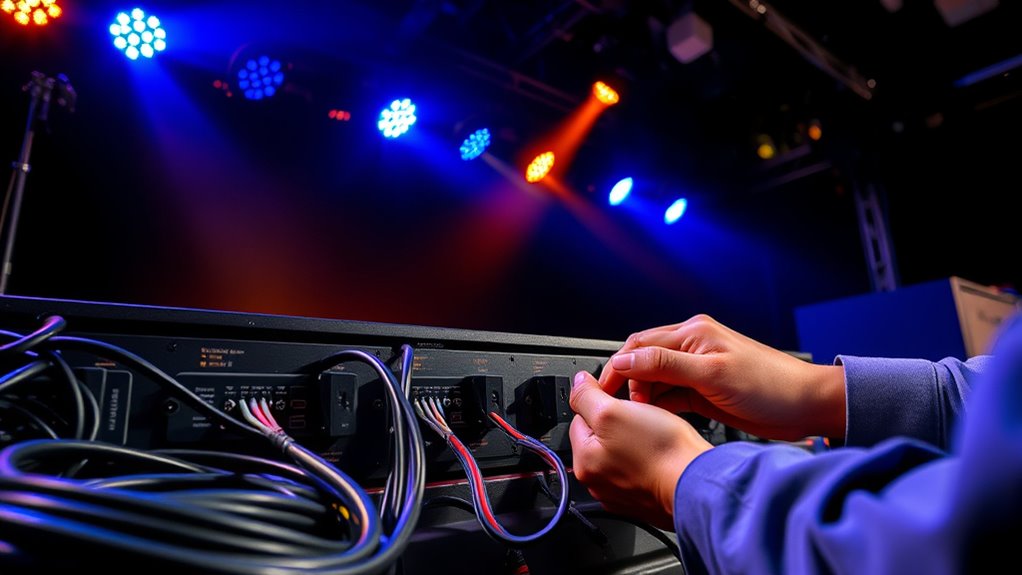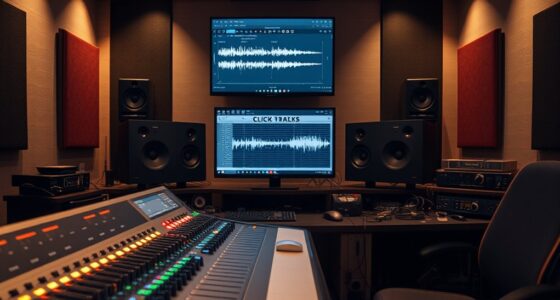To avoid ground loops and hum on stage, guarantee all your equipment shares a common ground by plugging everything into the same power strip or circuit. Use balanced cables like XLR or TRS, and keep cables organized away from power sources and transformers. Avoid daisy-chaining multiple outlets and never compromise safety with improper grounding methods. Incorporating ground loop preventers and following best grounding practices can make a big difference—continue to explore how to set up your gear for a hum-free performance.
Key Takeaways
- Use a single power strip or power conditioner to ensure all equipment shares a common ground point.
- Employ balanced cables (XLR, TRS) to reject noise caused by ground loops.
- Keep stage wiring organized, reroute cables away from power sources, and minimize loop areas.
- Utilize ground isolators or hum eliminator devices to break ground loops safely.
- Verify all equipment is plugged into the same electrical circuit whenever possible.

Ground loops are a common cause of hum and noise in audio and electronic systems, but you can prevent them with some careful setup. Understanding the ground loop causes is essential to avoiding unwanted hum on stage. Essentially, a ground loop occurs when multiple devices are connected to different ground potentials, creating a loop that allows current to flow unexpectedly. This unwanted current results in 60Hz hum or buzzing that can ruin a performance. To troubleshoot these issues effectively, you need to identify where the ground loop causes are originating and implement specific techniques to break the loop.
Ground loops cause hum and noise; identifying and breaking them is essential for clear audio performance.
Start by checking your connections. Confirm all your audio equipment shares a common ground point whenever possible. Using a single power strip or power conditioner can help maintain a consistent ground reference. If you’re using multiple outlets, avoid daisy-chaining power strips or plugging gear into different circuits, as this can introduce ground potential differences. Sometimes, a simple solution is to lift the ground on a device using a ground lift adapter, but this should be done cautiously and only if it’s safe and compliant with electrical codes. Remember, safety always comes first—never compromise on grounding safety to eliminate hum.
Next, consider the use of ground isolators or hum eliminator devices, which are designed to break ground loops without creating safety hazards. These devices work by isolating the audio signal from the ground loop, preventing unwanted current flow. Additionally, balanced cables and connectors—such as XLR or TRS—are effective troubleshooting techniques because they are designed to reject noise caused by ground loops. When setting up, ensure your instruments, microphones, and other gear are properly grounded and connected with quality, shielded cables. Proper grounding techniques are crucial for a stable setup and can greatly reduce hum issues.
Another troubleshooting approach involves systematically disconnecting and reconnecting your gear. Start by disconnecting everything and then reconnect piece by piece, listening for hum to identify the culprit. If you find a particular piece of equipment or cable causing noise, replace it or adjust its grounding setup. Sometimes, moving your gear physically to reduce loop areas or rerouting cables away from power sources and transformers can help minimize ground loop causes.
In a live environment, it’s crucial to be methodical. Keep your stage setup clean and organized, avoid excessive ground connections, and verify that all devices are on the same electrical circuit if possible. Troubleshooting techniques like checking grounding points, using isolation devices, and employing balanced cables enable you to pinpoint and eliminate ground loops effectively. With patience and careful setup, you can maintain a hum-free performance, ensuring your sound is clear and your stage looks professional.
Frequently Asked Questions
Can Ground Loops Cause Permanent Damage to Audio Equipment?
Ground loops generally don’t cause permanent damage to your audio equipment, despite common ground loop myths. They produce hum and noise, but your gear remains safe from harm if used correctly. To guarantee equipment safety, avoid creating ground loops by using proper cabling and grounding techniques. Always check your connections and avoid daisy-chaining multiple devices to prevent hum issues, but rest assured, ground loops aren’t likely to damage your gear permanently.
How Do I Identify if a Ground Loop Is Present?
Imagine Sherlock Holmes with a modern twist—if you suspect a ground loop, listen for symptoms like persistent hum or buzzing in your audio. You can troubleshoot by unplugging and replugging equipment, isolating devices, or using ground lift adapters. If the hum disappears or changes, it’s a sign of a ground loop. These methods help you identify and eliminate ground loop symptoms quickly, ensuring cleaner sound on stage.
Are There Specific Cables Designed to Prevent Ground Loops?
Yes, there are cables designed to prevent ground loops, like shielded cables and those with ground loop isolation features. Shielded cables help minimize interference, while ground loop isolation cables break the electrical connection that causes hum. Using these specialized cables on stage can considerably reduce ground loop issues, ensuring cleaner sound and fewer hums. Always choose equipment with proper ground loop prevention features for the best results.
What Are the Best Grounding Practices for Stage Setups?
You should implement proper grounding techniques by connecting all your equipment to a single, solid ground point to prevent loops. Use balanced cables and keep power and audio cables separated to reduce interference. Equipment isolation is essential—consider using isolation transformers or ground lift adapters when necessary. Regularly check your connections for secure, proper grounding, and avoid daisy-chaining power strips to minimize hum and noise during your stage setup.
How Does Cable Length Affect Ground Loop Issues?
Cable length considerably impacts ground loop issues because longer cables increase the chance of interference. Using balanced cables with proper cable shielding helps minimize noise, even over extended distances. Keep cables as short as possible to reduce potential ground loops, and guarantee your shielding is intact to block unwanted hum. This way, you maintain clear sound quality, preventing ground loop hum caused by long cable runs and inadequate shielding.
Conclusion
Think of grounding like a river’s flow—if it’s smooth and steady, your sound stays clear and pure. Avoid ground loops by keeping your gear properly connected and using isolation devices. When you manage your ground paths carefully, you prevent hums and buzzes from sneaking in like unwanted weeds. Stay vigilant, and your stage will shine with clean, crisp sound—like a well-tuned instrument in perfect harmony. Keep the currents flowing right, and your sound will always stay true.










